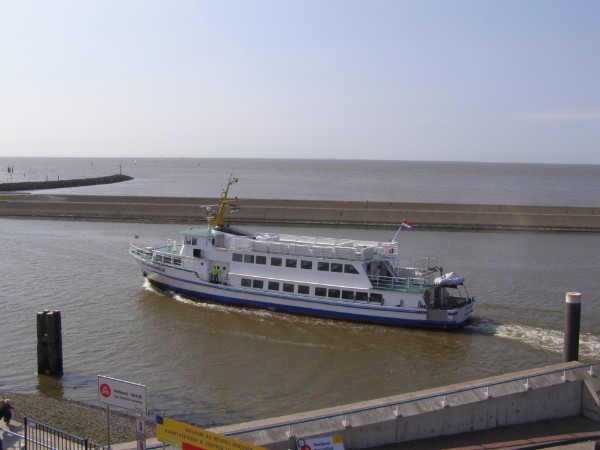Eigen Veerdienst Terschelling
The Eigen Veerdienst Terschelling (EVT) or translated Own Ferryservice of Terschelling was formed in 2008 after a new law had been issued to make it possible for firms to compete on the Dutch waterways. It was owned by several businesses, also from Terschelling, an island north of the Dutch province of Friesland between the North Sea and the Waddenzee. They were a direct competitor to the established Rederij Doeksen that runs the service between Harlingen in Friesland and the islands of Terschelling and Vlieland. As the name of the company suggests, it has to be a company owned by the islanders of Terschelling, and it was announced that stocks will be able for purchase for them. Within the time the company operated, non of the stock was purchased by Terschelling's inhabitants. Also, the people who used the ferry had a say about the departure times, the ferries that were to be used and the price for a crossing. EVT was somewhat cheaper then Rederij Doeksen.
The company started sailing with one ship, the Willem Barentz, but this ship was sold at short notice in 2009 when the announcement was made that a 2005-built catamaran would join the company as a replacement. This ship would also be named Willem Barentz but the delivery was delayed and a very small 1964-built ferry was used for the time being. This ship was named Stortemelk.
Rederij Doeksen was not very pleased with the small competitor and a limited sailing scedule was the only option for EVT. Also the council of Terschelling was not in favour of two competitors on the route, despite the free market law, that makes competition possible. They indicated that, in spite of the law, no permits for using the port at Terschelling would be given to the EVT. During 2009, the situation became very edgy when EVT offered more sailings then agreed and on times too close to the Doeksen-ships. Rijkswaterstaat, the company that takes care of the Dutch waterways and the companies that use them, acted by locking off the landingstage at Harlingen with a chain, so no sailings could be offered. EVT uses the same landingstages as Rederij Doeksen in both Terschelling and Harlingen.
As a reaction, the owner of EVT cut the chains off and the company still offered their sailings. When the gate was locked again, EVT passengers had to climb the fence using kitchen-ladders, that were provided by the EVT. This situation was of course far from normal and the Boat Commission that consists out of Rijkswaterstaat, the councils of Terschelling, Vlieland and Harlingen as well as Doeksen, agreed that the chains would be removed and more sailings could be offered by EVT starting from may 2010. The chains indeed were removed when I took my pictures of the Stortemelk at the 23rd of may 2010, but a lawsuit has been issued by EVT against Rijkswaterstaat and the council of Terschelling to know or the company is delibrately obstructed.

The Stortemelk, as you can see, sails almost empty from Harlingen on a sceduled service. Although the gate is open, just a handfull of people use the opportunity to sail between sailings of Rederij Doeksen and make use of this service provided by EVT. The company is not very popular among islanders, who are almost all in favour of just one operator. Despite this, the company hopes on improvement. The ship was built in 1964 in Norway at the Lindstöls Skibs Verft at Risör. Her first name was Sundbuss Henrik II and she was used by Sundbussarna for the Helsingborg to Helsingör service. Then, she was smaller as she was being lenghtened by 6,35 meters in 1986. She continued sailing for several operators in the Baltic Sea and around Germany and Denmark and has been renamed several times. In 1975 she became EMS Clipper for Dollar Seabus Limited and in 1979 she was renamed Baltic Clipper for Rolf Böttcher. Five years later, in 1984, she became Sund Clipper for M&R Schiffahrts of Germany. This company went into liquidation in 1990 and the ship was sold as Ostsee for the also German Förde Reederei. She was again sold to Rederij Rijf of Terschelling in 1998, getting her homeport she now still has. It was also then when she was renamed Stortemelk, and she was used as an excursion vessel out of Terschelling on the Waddenzee. In 2008 she was sold to the EVT as a relief vessel for the catamaran Willem Barentz. Stortemelk is a name that means 'dumped milk', or in Dutch 'gestorte melk', a nickname given by sailors to a strech of water between Vlieland and Terschelling that has a white colour sometimes due to the high waves in outgoing tide. At that time it has the same colour as dumped milk. The name was later changed from 'gestorte melk' to Stortemelk.
Because of all problems that EVT faced during their operations, also with the Dutch Rijkswaterstaat, the company was discontinued from the end of the summer of 2013 onwards. It seems that although it is a free market economy, when local markets are not able to handle two operators is doesn't really work that way and one of the two will have to cease operations.

